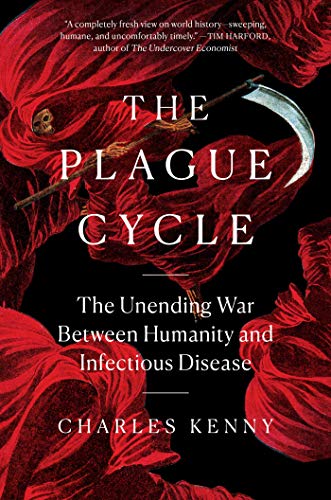Don’t Fear the Reaper: A Review of The Plague Cycle by Charles Kenny

Did you know that Japanese doctors once requested Dutch cowpox scabs to help inoculate people against smallpox? And that in response to higher wages after the Black Death, Edward III attempted to ban better diets and attire? Or that according to Marco Polo, the Khan often entertained forty thousand guests at banquets, where guests wore fine napkins of silk and gold to cover their mouths and noses?
Read Charles Kenny’s new book, The Plague Cycle: The Unending War Between Humanity and Infectious Disease, to learn more about these events, public health through the ages, and an optimistic approach to infectious diseases. And you might even become more skeptical of Covid-19 lockdown orders.
There would be much value in the book if Kenny had only synthesized the growing literature on the history of public health and infectious diseases. Kenny goes further, however, by developing the argument that there is a back-and-forth relationship between individuals, the civilizations that arise from their actions and interactions, and the spread and prevention of infectious diseases. Kenny slowly develops this argument throughout the book with anecdotes and studies of particular infectious diseases, along with a Malthusian framework used for clarification and as a foil.
Kenny’s interpretation of Malthus suggests that as populations rise where land is relatively scarce, people will be less able to acquire food from farming and/or hunting (Malthus was writing in the late 18th century). As people eat less, their productivity falls until population growth puts people at subsistence. And as population growth continues beyond this subsistence level, mortality rates rise due to famine, disease, and violence, which then lowers population growth, and the cycle begins again.
Infectious diseases, thus, can lessen Malthusian pressure and temporarily improve welfare; improvements in health can do the opposite — according to Malthus. Kenny uses this model as a foil to motivate his historical treatment of diseases and to show how changes in knowledge — along with urbanization and the accumulation of wealth — change the tools of prevention and encourage people to break out of the Malthusian trap. Kenny ends the book with the following remark about Malthus: “Malthusian fatalism had a declining empirical basis in the nineteenth century. Now it has no basis at all.” (233)
There are many implications of Kenny’s logic, e.g., that Malthus was only partially correct and that individuals can and often do break away from the Malthusian state of poverty. Here is one implication I found particularly interesting. Referring to a failure to take advantage of 20th century advances in health and medicine Kenny states,
“The few large firms [in the Middle East] there were kept in business through government contracts and favorable treatment by regulators — not by producing globally competitive products. There’s no Middle Eastern equivalent of Hyundai or Lenovo, exporting cars or computers around the world…The lesson for Africa—still undergoing the transition to low birth rates—may be that a well-managed demographic dividend leads to East Asian growth rates, while a poorly managed age transition leads to the Arab Spring and (potentially) its grim aftermath.” (162)
The book, which Kenny began thinking about in 2015, is meant for a popular audience and largely follows standard histories of public health and outbreaks and epidemics of infectious diseases — from cholera to smallpox and from malaria to HIV/AIDS.
Kenny references and extends numerous standard-bearers in the public health history genre including McNeil’s Plagues and Peoples, and Porter’s Health, Civilization, and the State, which he supplements with recent academic literature from public health and economics. Readers interested in a particular disease episode should start with Kenny’s book, peruse the index, and then follow the references for more extensive treatments.
At times, however, Kenny does provide great detail. For example, here is Kenny’s description of Edward Jenner — of the smallpox vaccine fame — and his other interests:
“He spent a decade working on his natural history of the cuckoo, published in the Philosophical Transactions of the Royal Society…Jenner’s research had involved extensive observations, numerous dissections, posting cuckoo stomachs to London for further analysis, and swapping eggs between nests. That was just one part of a scientific exploration that led to his workroom being filled with such specimens as rooks, swifts, dogs, pigs, a bottlenose dolphin, and numerous hedgehog heads alongside human hearts (Jenner was one of the first to analyze the causes of angina). He became an expert in sexing eels, and constructed an early hydrogen balloon, which he flew over Berkeley Castle.” (128)
The book is well written, sweeping, and at times disjointed, perhaps necessarily so as the history of many diseases spans centuries, outlasts empires, and overlaps with other diseases. One overall critique, however, is that the full argument only develops and becomes clear towards the latter chapters, which left me wondering why some of the histories were relevant. Yet, this was hardly a reason to set it aside.
There is a refreshing optimism that pervades Kenny’s brief commentary — an optimism supported by global declines in infant mortality rates and increasing life expectancies since the middle 1800s — due to falling prevalence and mortality rates of infectious diseases (this optimism is shared by Angus Deaton in his work on health and wealth). Kenny partially attributes these declines to improvements in sanitation, water quality, diets, and changing norms of hygiene, especially after the advent of the germ theory of disease.
But the progress is also due to the improvement of human immune systems, which partially depend on exposure, genetics, diet, stress, etc. Kenny suggests that much of our ability to ward off diseases comes from our immune systems — as individuals and as groups of people — which we acquire over centuries of evolution through our interactions with different pathogens and diseases.
For example, Kenny states, “It can sound counterintuitive — or at the very least, like bad parenting — but setting babies down on the rug and giving them a bit of exposure to bacteria carried on cockroaches, mice, and cat dander may make them less likely to develop asthma later on. Conversely, exposing children to triclosan — the active ingredient in antibacterial soap — may increase the likelihood they’ll be diagnosed with allergies or hay fever.” (199) At the same time, however, diseases can adapt to immune systems, which explains their persistence.
Fortunately, people can do more than solely rely on their immune system — as helpful as those systems are. People can change their behavior to avoid infection. Regarding diseases like HIV/AIDS, malaria, and others, Kenny indicates individuals often have a great ability to avoid infection — and to partially lower prevalence and mortality rates — especially if they have an adequate understanding of how a disease spreads and which preventative measures are relevant. Such avoidance behavior occurs with or without vaccines and with or without governmental public health programs. Referring to the almost eradicated guinea worm, “The approach didn’t even take a vaccine or deworming drugs — just people filtering their drinking water through a cloth or sieve and disinfecting or avoiding infected water sources.” (142)
And there is nuance. Kenny explains there is a double-edged sword aspect to economic growth and urbanization. That is, living in dense urban spaces facilitates growth and prosperity for a majority of its inhabitants, and it also comes with a higher threat of infectious diseases. Kenny points to New York and London as exemplars of this tension. Yet, Kenny hints that the positives of urban life outweigh the costs, even accounting for the spread of infectious diseases. Furthermore, we should be careful when we think we can mitigate disease risks by interfering with standard economic and social interactions; the costs often outweigh the benefits.
Kenny also teases out numerous implications for public health today, especially for a post-Covid-19 world. For example, much of the factors that facilitate meaningful responses to the spread of infectious diseases — both public and private — come from trade and the resulting accumulation of wealth. While not mentioned specifically, economic freedom is a relevant factor too, especially for responses to influenza epidemics (see here and here). Trade creates wealth as individuals can better engage in their comparative advantage; and they are more likely to substitute goods they care less about for those they prefer.
This is the magic of free trade, open immigration, and open borders. Indeed, Kenny states, “Trade enables the US and the rest of the world to get vital medical equipment at a far lower cost than if everyone produced it all at home. It’s why early efforts to restrict trade in that equipment in 2020 were a tragic mistake for everyone.” The keyword is everyone. He continues: “For all that globalization was, in the past, a force for spreading disease, today it’s simply central to planetary well-being.” Not just the well-being of your city or country, Kenny genuinely means everyone.
Travel restrictions find little support here. Contrary to the oft-repeated conclusion that commerce generally facilitates travel, border crossings, and the spread of disease, Kenny recognizes the historically contingent nature of the trade-leads-to-disease argument. Obviously when trade depended on physical interactions, those interactions facilitate the spread of germs. It is not quite clear that trade today via modern communication systems, digital, and online platforms do the same. And he recognizes that our connectedness means the costs of interference are much larger than when we last contemplated policies like travel bans and quarantine to prevent the spread of disease.
He states that, “The limited efficacy of travel bans in the face of a frequently asymptomatic and rapidly spreading disease was on full display with Covid-19.” (182) To be effective, however, such orders should be given when officials know which individuals are infected and, presumably, before they travel. These conditions are rarely met. The efficacy of such bans becomes even more questionable when they persist beyond their period of usefulness, e.g., American travel bans that lasted months after the initial outbreaks.
Kenny is critical of general lockdown orders too: “Testing and isolating the sick, along with their contacts, was a successful strategy against Ebola in 2014 and against Covid in 2020. ‘Social distancing’ was a necessary but expensive fallback in 2020 when we didn’t know who was infected.” (180) Kenny continues with a longer description,
“Lockdowns were never designed to be a stand-alone solution. Rather, they were a short-term strategy to buy time for better strategies and to prevent hospitals from being overwhelmed by patients. And it’s worth repeating that people sensibly and instinctually want to stay away from others when there’s a new disease spreading with no cure. At the start of the Covid-19’s spread, it didn’t take regulations from above for people to stop going to restaurants and cut back on shopping. But for whatever highly contagious, often asymptomatic novel infection that comes next, every country needs to be efficient at using the time provided by lockdowns to come up with less restrictive methods to slow spread and build confidence. Those methods should include mass testing and tracing that allows for selective isolation.” (181)
Ultimately, Kenny encourages us to abandon our archaic attachments, i.e., our fear of disease; we have too much to lose by indulging our primal fears. He would rather we embrace diseases and germs. Not only would such an embrace enhance and diversify immune systems, it would improve our knowledge of how diseases spread and how we can better avoid infection. We could then perhaps develop novel means of prevention, improve coordination within and across governments (or limit their interference), and lessen antibiotic resistance. There is more to discuss in Kenny’s book, e.g., military vaccine programs, encouraging global financing for research and development, improving health systems, but I’ve already taken up too much space.
The Plague Cycle is an excellent treatment on the history of infectious diseases and the complex relationship with human societies, and it offers new ways to think about disease prevention going forward. Do pick it up with those reasons in mind, not just because of the implications for Covid-19.











